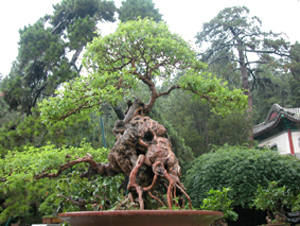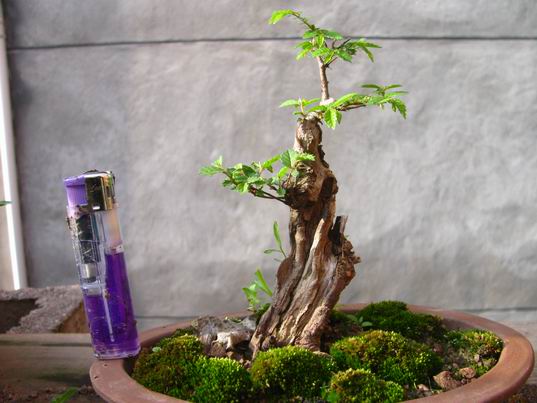How to cultivate Elm Bonsai making of Elm Bonsai
Elm is a kind of bonsai material with good shape. Bonsai made of elm is very popular because of its changeable shape. Today, the editor is going to introduce to you how to raise elm bonsai and how to make it? Let's go and have a look.

Brief introduction of Elm
Elm leaves alternate, oval tip, leaf length 3-6 cm, width 1-3 m, edges neatly obtusely serrated, bark straight split, branchlets gray soft, widely spread. The flowers are small yellow and green, and the Samara is as round as a penny. The leaves, branches and stems of elm all have certain ornamental value. Its leaves are thin and dense, thick and hard, fresh and tender, bark irregular like scales, spotted lovely, branches soft and drooping, fluttering with the wind, Yiyi such as willow, stem although semi-rotten, or full of holes, but still strong, straight, immortal.
The posture of the elm tree is tall and straight, the bark is rough and longitudinally cracked, dark gray, the twigs are soft and suitable for banding, and the old stump of the old tree is even more elegant. Although it is semi-decaying, the branches and leaves can still grow normally, which means that the ancient tree is full of spring. There are many varieties of elm, and hammer elm is suitable for making pile scenery, which has chic posture, grayish brown bark, irregular thin scale peeling off, small and dense branches and leaves, and high ornamental value. Can be cold-resistant, drought-resistant, barren, no choice of soil, strong adaptability, is a good material for bonsai production. In addition, there are small leaf elm, the tree shape is small, the leaf length is only 1 meter or so, and the branches are luxuriant, which is also a good material for making bonsai.

How to raise elm bonsai
First, strengthen the light. It is sunny and slightly shady, so it should be placed in a sunny place. If the sun is not enough, it will only grow branches, poor leaf color, and easily lead to insect pests.
Second, keep the basin soil moist without water stains. Elm trees like to be born in wet places, but they are also afraid of water stains.
Therefore, the spray should be thoroughly watered, and should be watered once in the morning and evening in the middle of summer. In case of waterlogging in the basin, it should be dredged as soon as possible.
Third, it is necessary to apply fertilizer properly. The peanut cake is cooked into water and liquid fertilizer, and the peanut cake can also be broken into thumbs and buried in the soil, and Xiji uses some compound flower fertilizer. Fertilization should be applied once in early spring and early autumn, not more.
Fourth, pruning and plastic surgery should be timely. The sprouting power of elm is very strong, and the three group leaders are also very fast. If they are not pruned, the pile scenery will lose its ornamental value. Pruning and plastic surgery can be carried out in autumn. First cut off useless branches and diseased branches, and then prune them according to the molded or molded posture.
5. Elm trees are often harmed by aphids and clams, which can be sprayed with omethoate 1000 times. Elm pile is not only used for bonsai viewing, but also can be used as a tree embellished in the courtyard. However, the big tree stump should be transplanted with guest soil, and it should be carried out before sprouting leaves in winter and spring. After planting, wrap the stem with rice straw mixed with yellow mud water, and often water it to ensure that the soil and straw are moist.

Making of Elm Bonsai
First, Miaoyuan
Elm stump is mostly dug to the wild, wild stump posture strange and changeable, winding, ancient and lovely, fast shaping, high ornamental value.
Second, modeling
1. The best planting time is from February to March in spring, and it can also be done in autumn. The roots, branches and leaves should be pruned before planting. In order to prevent the elm tree from losing too much sap and causing the wound to rot and die, you can apply a medical ophthalmic medicine or sulfonamide ointment to the wound, and then plant it on the ground or in an earthen basin with plain sand. After a bad tree stump, it is necessary to put on a fine basin. The use of loose and fertile pastoral soil or rotten leaf soil is beneficial to root development. Its bonsai basin is suitable to use purple sand pottery basin or glazed pottery basin, the shape is mainly rectangular and oval, and the bonsai color is better in plain color.
2. The styling of elm should be mainly cut, cut and used. According to the basic form of the old pile, many kinds of styles can be made, such as straight dry type, curved dry type, inclined dry type, horizontal dry type or cliff type and so on. Because of its well-developed roots, it may also be made into root-type or stone-attached bonsai. The elm branches are soft and can be tied into a variety of bonsai styles. The branches and leaves of Yucun are resistant to pruning, so they can be cut into clouds, or they can be cut into the desired shape according to the creative intention of the producer.

III. Maintenance
1. Elm trees in the place are light-loving and cold-resistant, so they should be placed in an environment with good light and good air circulation. In summer, bonsai can be placed on boards and foam boards to reduce root burns caused by heat conduction on the ground.
2. Watering should keep the basin soil moist, but not stagnant water. When the weather is hot, you can spray water to the ground in order to humidify and cool down. However, it is not appropriate to spray water on the leaves, lest the leaves are too large to affect the shape of elm bonsai.
3. Fertilization should be applied once a month in the growing season, mainly nitrogen and potassium, and should not be applied in winter.
4. Plastic elm trees have strong germination, so they should be pruned frequently in the growing season. Picking leaves of elm can promote leaf germination and make leaves smaller. Before the Department of Energy enters the autumn, the old leaves are removed several times. After about 20 days, new leaves can grow, re-enter the ornamental period, and delay falling leaves.
5. Generally, the basin is turned once every 3 years, and the time is appropriate to choose the budding period in spring.
6. pest control can spray dichlorvos to control golden flower insects, shell insects, longicorn beetles and other pests.

The above content is our introduction about how to raise elm bonsai. Do you all understand? According to the size of its leaves, elm can be divided into three types: large leaves, middle leaves, and leaflets. The middle leaf and lobular tree species can be used as bonsai wood, while the leaves of lobular elm are small, chic and resistant to pruning, so they are good materials for making miniature bonsai. The most commonly used is hammer elm.
But it is not suitable to accumulate water. When the weather is hot, you can spray water to the ground in order to humidify and cool down. However, it is not appropriate to spray water on the leaves, lest the leaves are too large to affect the shape of elm bonsai.
3. Fertilization should be applied once a month in the growing season, mainly nitrogen and potassium, and should not be applied in winter.
4. Plastic elm trees have strong germination, so they should be pruned frequently in the growing season. Picking leaves of elm can promote leaf germination and make leaves smaller. Before the Department of Energy enters the autumn, the old leaves are removed several times. After about 20 days, new leaves can grow, re-enter the ornamental period, and delay falling leaves.
5. Generally, the basin is turned once every 3 years, and the time is appropriate to choose the budding period in spring.
6. pest control can spray dichlorvos to control golden flower insects, shell insects, longicorn beetles and other pests.

The above content is our introduction about how to raise elm bonsai. Do you all understand? According to the size of its leaves, elm can be divided into three types: large leaves, middle leaves, and leaflets. The middle leaf and lobular tree species can be used as bonsai wood, while the leaves of lobular elm are small, chic and resistant to pruning, so they are good materials for making miniature bonsai. The most commonly used is hammer elm.
Related
- Wuhan Hospital Iron Tree Blooming Result Was Instantly Frightened by the Gardener Master
- Which variety of camellia is the most fragrant and best? Which one do you like best?
- What is the small blue coat, the breeding methods and matters needing attention of the succulent plant
- Dormancy time and maintenance management of succulent plants during dormancy
- Minas succulent how to raise, Minas succulent plant pictures
- What are the varieties of winter succulent plants
- How to raise succulent plants in twelve rolls? let's take a look at some experience of breeding twelve rolls.
- Attention should be paid to water control for succulent plants during dormant period (winter and summer)
- Watering experience of twelve rolls of succulent plants
- Techniques for fertilizing succulent plants. An article will let you know how to fertilize succulent plants.



